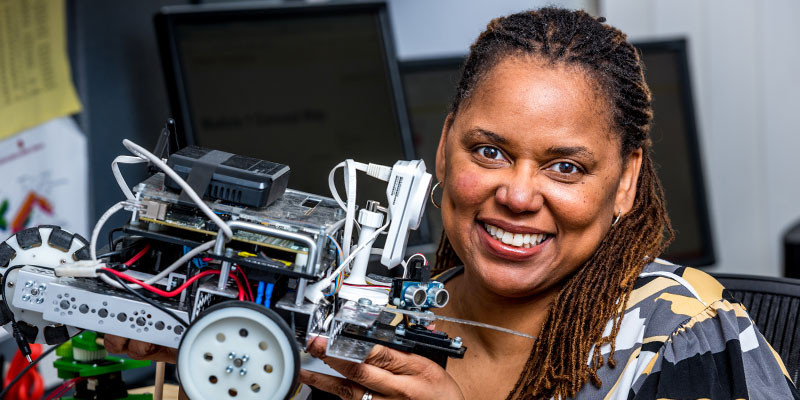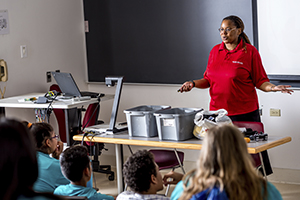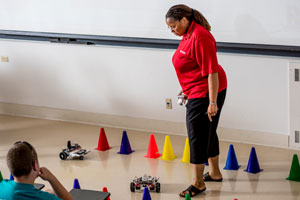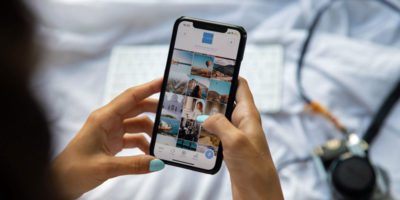Dr Carlotta Berry is a professor in the Department of Electrical and Computer Engineering at Rose-Hulman Institute of Technology. Her expertise includes educational mobile robotics and enhanced human-robot interfaces, as well as developing recruitment and retention activities for underrepresented populations in electrical and computer engineering. Carlotta is also the 2021-2024 Dr Lawrence J Giacoletto Endowed Chair for Electrical and Computer Engineering at the Institute.
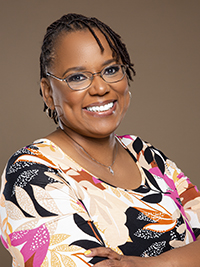
“Engineering has a major marketing problem which makes it difficult for diverse populations to see themselves in the field.”
Using robotics to connect people of all ages, genders, races and backgrounds
I am an electrical engineer with a focus on controls and robotics. Some people refer to me as a robotics engineer and this also works. I teach engineering, circuits, signals and systems, controls, robotics, and design. I primarily focus on mobile robotics and use it to teach other concepts, like electronics, mechanics, and software development.
I think the coolest thing about robotics is how multidisciplinary it is, and the way it can be used to connect people of all ages, genders, races, and backgrounds.
I started out wanting to be a high school math teacher but then changed my mind. However, I have two bachelor’s degrees to satisfy both of my loves – math and engineering. I am an educator at heart, so I knew that with a math and engineering degree, I would be able to explore both of my interests. I have often felt like my post-retirement job would be to go back and teach high school math.
I have four degrees in total: A bachelor of science in math from Spelman College; a bachelor of engineering in electrical engineering from Georgia Tech; a master’s of science in electrical engineering from Wayne State University; and a PhD in electrical engineering from Vanderbilt University.
My master’s degree was focused on designing a controller for a bending lehr at a car windshield manufacturer. My PhD dissertation focused on designing a human-robot interface to improve human-robot interaction for mobile robots.
I tutored and taught all through my undergraduate and graduate school because I knew this was my ultimate destination. However, my first job out of university was working as a controls engineer for Ford Motor Company glass division. I worked on the line that assembled the car windshields, where my job was to perform maintenance, coding and updates for the industrial robots and programmable logic controllers.
My next job was at Detroit Edison electrical utility company. I worked on the distributed control system for the coal power plant. After that, I left industry to get my PhD and become a professor. This last year, while I was on sabbatical, I returned to industry for the first time in 25 years, to work as an automation engineer for a pharmaceutical company.
Constantly in motion solving a diverse set of problems
The most amazing thing about being a professor is that no two days look exactly the same. Although I do similar things every day, I am constantly in motion and my mind is stimulated. I get to be creative, innovative and design solutions to a diverse set of problems.
A professor teaches as well as working on professional development, research and doing service. So, a typical day may include preparing lectures, teaching classes, or giving exams. I also hold office hours to help students with their assignments, selecting classes or making career choices.
I also have undergraduate and graduate students who conduct research and provide them with guidance and advice, as well as doing service to my profession, community, and university.
Service would be committee work, reviewing papers, reviewing proposals, serving as an editor, doing robotics workshops for kids, judging robotics workshops, and giving presentations on diversity, STEM, and robotics. In addition to this, I write papers and proposals, as well as travelling to conferences to publish and present my work.
Exploring human-robot interaction
I am most interested in human-robot interaction to examine how a person can work with a robot or team of mobile robots to achieve some task. The human will be typically remote, so there must be an intuitive, user-friendly, and usable human-robot interfaces that increase situational awareness and reduce mental workload.
I also work with students on creating heterogeneous (diverse) teams of robots that cooperate to achieve a task.
Unique and effective: Amplifying diverse voices to develop better solutions
Engineering has a pathway, not a pipeline problem. This means that there is not just one way to become an engineer like a pipeline but rather many paths. This journey may be seen as an obstacle course that students have to navigate. When students encounter these obstacles or have to take a detour or leap over hurdles, our goal is to foster a support network to help them achieve their goals.
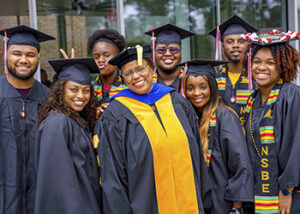
Engineering has a major marketing problem which makes it difficult for diverse populations to see themselves in the field. People cannot be what they cannot see and what they are not encouraged to pursue, so it is important to amplify diverse voices in the field as much as possible to make it more commonplace.
Diversity in engineering is important because when certain voices are missing from the room, so is their unique perspective. Since engineers design the systems and processes that improve the world or solve problems, it is important to have a diverse team.
Research has shown that diverse teams yield the most unique and effective. There are several examples online of what happens when this diverse model is not followed. Just google “racist soap dispenser” on YouTube.
A call to action for an anti-racist institution
During the pandemic, when everyone was working from home, there were several events that happened within weeks of each other: George Floyd was killed, Breonna Taylor was killed, Ahmaud Arbery was killed. Then, #BlackInTheIvory was trending on Twitter and bird watcher, Christian Cooper, was racially profiled in Central Park.
All of these events highlighted the bias and inequities that Black people face. Out of this, the Black In X movement was born, where several ‘Black In’ organisations came together to amplify their message through social media. Currently, Black In X has 83 STEAMX organisations as members.
I worked with my colleagues, Dr Monica Cox, and Dr Tahira Reid Smith to organise a meeting of Black faculty members in June 2020 as a call to action.
The founders of Black In Engineering were concerned that our voices were not represented in the discussion. In particular, with respect to #BlackInTheIvory, where Black people shared their experiences working in academia. Through BIE, we released a call to action for an anti-racist institution and started a media and messaging campaign including podcasts, articles, interviews, and videos.
Alongside this, Black in Robotics also identified a need to make sure we had a seat at the table when AI systems were being designed to make sure that they did not have a systemic bias towards people of colour.
Showing girls the relevance of their work in robotics
Women and girls can provide a unique perspective to the robotics field. They can also help bring awareness to the unique needs of our community and how that affects robotics use and design.
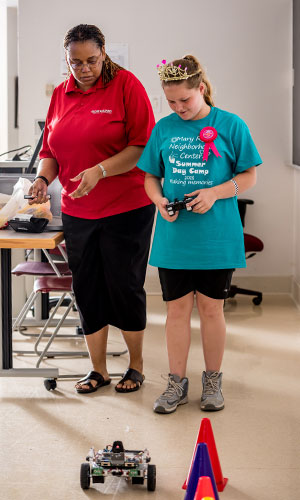
Teaching and connecting with others to bring them to STEM
My year of sabbatical and the pandemic has been very good to me in professional terms, despite how difficult it has been working from home and social distancing.
I was considered one of 30 Women to Know in Robotics; I got the FIRST Indiana Gamechanger Award; the TechPoint Foundation for Youth Bridge Builder Award; second place in the WE Innovate awards; and I became a fellow of the American Society of Engineering Education.
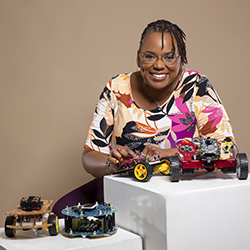
I don’t do what I do for the honours, awards and acknowledgements, but it always feels good to be appreciated. I do what I do because it is my life’s mission and purpose, and I don’t know what else I could be doing. My spiritual gift is teaching and connecting with others to bring them to STEM.
This was something I decided to do when I was an undergraduate student in engineering because it was so important to show it to a more diverse audience. Engineering needs to be portrayed as energetic, unique, fun, and personable.
Heading back to the classroom
My sabbatical is coming to an end, and I will be back in the classroom by the end of August. Therefore, I am trying to wrap up some of the many projects that I started during the pandemic/sabbatical.
I have to learn to delegate more, but the ones I am looking the most forward to are giving a presentation to MathWorks for the Juneteenth federal holiday in the US, giving a robotics workshop at a Houston community college, continuing to offer virtual robotics and STEM workshops and expanding the program in 2022, and publishing my first fictional book on Black Women PhDs in STEM.
https://www.linkedin.com/in/carlotta-berry-phd/
https://linktr.ee/DrCarlottaABerry
https://twitter.com/rosehulman
All images by Bryan Cantwell, Rose-Hulman Institute of Technology, except where stated.

